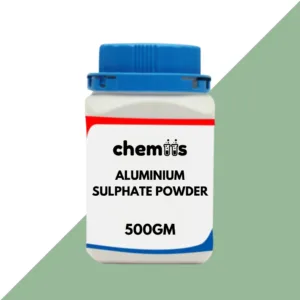Sodium Thiosulphate Anhydrous (Na2S2O3) is a white, crystalline, anhydrous form of sodium thiosulphate. It is an important chemical compound used in various industrial, medical, and laboratory applications due to its properties as a reducing agent. Unlike its hydrated forms, Sodium Thiosulphate Anhydrous contains no water molecules in its crystal structure, making it highly concentrated and useful in processes where anhydrous compounds are required. It is highly soluble in water and is often used in areas such as photography, water treatment, chemical analysis, and gold extraction.
Applications:
1. Water Treatment and Pollution Control
- Dechlorination: Sodium Thiosulphate Anhydrous is frequently used in water treatment plants to neutralize chlorine and chloramine. By acting as a reducing agent, it neutralizes chlorine’s oxidative properties, making water safe for aquatic life and industrial use. This is particularly useful when treating drinking water or wastewater.
- Heavy Metal Removal: In industrial wastewater treatment, Sodium Thiosulphate Anhydrous is used to remove heavy metals such as gold, silver, and copper. It forms soluble complexes with metal ions, which can then be removed from effluent systems.
2. Photography and Film Processing
- Photographic Fixing Agent: In the field of traditional photography, Sodium Thiosulphate Anhydrous is a key component of photographic fixers. It removes unexposed silver halides from photographic film and paper, making the image stable and preventing it from being exposed to light. This is an essential step in ensuring that photographic images are preserved.
- Silver Recovery: Sodium Thiosulphate Anhydrous can be used in the recycling process to recover silver from photographic waste. The compound reacts with silver halides in photographic materials, allowing for the recovery of silver.
3. Gold Mining and Extraction
- Gold Leaching: Sodium Thiosulphate Anhydrous is widely used in the gold mining industry as an alternative to cyanide for gold extraction. It dissolves gold from its ore and forms a soluble complex, allowing the gold to be separated and purified. This method is considered safer and less toxic than cyanide-based extraction.
- Gold Refining: Beyond leaching, Sodium Thiosulphate Anhydrous plays a role in refining gold from ores with lower gold content. It is also used to refine gold from scrap materials, making it a critical chemical in the precious metals industry.
4. Medical Applications
- Cyanide Poisoning Treatment: Sodium Thiosulphate Anhydrous is used as an antidote for cyanide poisoning in emergency medicine. It works by converting cyanide into thiocyanate, a much less toxic compound, which is then excreted through the urine. This makes it an essential treatment in cases of cyanide exposure or poisoning.
- Topical Uses: It has also been explored for use in treating certain skin conditions, such as acne or eczema, as it can help reduce inflammation and promote healing.
5. Chemical and Laboratory Uses
- Reducing Agent: In chemical laboratories, Sodium Thiosulphate Anhydrous is used as a reducing agent in various reactions. It can reduce iodine and other halogens, making it a useful reagent in laboratory settings.
- Iodometric Titrations: Sodium Thiosulphate Anhydrous is a key reagent in iodometric titrations, where it is used to determine the concentration of oxidizing agents like iodine or chlorine. The compound is titrated against a sample containing iodine, helping to quantify the concentration of oxidizing agents in the solution.
6. Textile Industry
- Dyeing and Bleaching: Sodium Thiosulphate Anhydrous is used in the textile industry as a discharge agent for dye removal and to bleach fabrics. It is especially effective in creating unique effects in fabrics by decolorizing or modifying the texture of dyed textiles.
7. Food Industry
- Food Additive: In some cases, Sodium Thiosulphate Anhydrous is used as a food additive for specific applications such as food bleaching and preservation. It is sometimes used to remove excess chlorine from water used in food processing.
Safety Guidelines:
- Personal Protective Equipment (PPE):
- Skin Protection: Always wear protective gloves and suitable clothing to avoid skin contact with Sodium Thiosulphate Anhydrous, as prolonged exposure can cause irritation.
- Eye Protection: Wear safety goggles or a face shield to protect the eyes from splashes or dust particles.
- Respiratory Protection: Inhalation of Sodium Thiosulphate Anhydrous dust should be avoided. Use a dust mask or respirator when handling large quantities or in poorly ventilated areas.
- Storage:
- Store Sodium Thiosulphate Anhydrous in a cool, dry, and well-ventilated area, away from heat sources, open flames, or strong acids and oxidizing agents. The chemical should be kept tightly sealed to avoid moisture absorption.
- The compound should be stored in its original container and away from incompatible materials.
- First Aid:
- Inhalation: If inhaled, remove the affected person to fresh air immediately. Seek medical attention if respiratory irritation or distress persists.
- Skin Contact: In case of skin contact, wash thoroughly with soap and water. Seek medical attention if irritation occurs.
- Eye Contact: If Sodium Thiosulphate Anhydrous contacts the eyes, rinse immediately with plenty of water for at least 15 minutes and seek medical attention if irritation persists.
- Ingestion: If ingested, do not induce vomiting unless instructed by a healthcare professional. Rinse the mouth with water and seek medical help immediately.
- Disposal:
- Dispose of Sodium Thiosulphate Anhydrous in accordance with local, state, and federal regulations. Small quantities can be neutralized using an appropriate neutralizing agent, while larger quantities should be handled by a licensed chemical waste disposal service.








Reviews
There are no reviews yet.